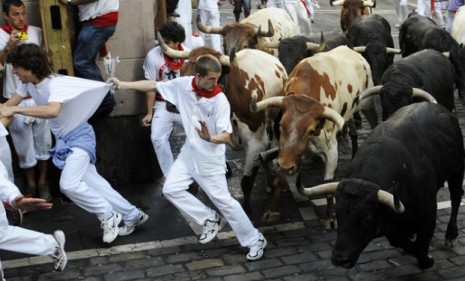Spain's Running of the Bulls: 7 curious facts
The controversial annual festival of San Fermin, bovine beasts, and machismo kicks off in Pamplona on Wednesday

On Wednesday, tens of thousands of people packed into the main square in Pamplona, Spain, for the party that kicks off the famous Running of the Bulls. Immortalized by Ernest Hemingway in The Sun Also Rises, the annual week-long San Fermin Festival, in which half a dozen horned beasts and countless adventurous humans go running through the streets en route to the bullfighting ring, is a longstanding, controversial tradition. Here, seven interesting facts:
1. The event is hundreds of years old
Historians trace the Running of the Bulls as far back as 1385, when bullfights first began in Pamplona, and it became a tradition to run the animals through the city beforehand. Many say the tradition officially began in 1591, when three main summer events — the festival of San Fermin, the livestock fair, and the bullfighting festival — were combined.
The Week
Escape your echo chamber. Get the facts behind the news, plus analysis from multiple perspectives.

Sign up for The Week's Free Newsletters
From our morning news briefing to a weekly Good News Newsletter, get the best of The Week delivered directly to your inbox.
From our morning news briefing to a weekly Good News Newsletter, get the best of The Week delivered directly to your inbox.
2. The runners' uniforms may honor a saint... or butchers
Mozos, as the adrenaline-hungry adventurers who run with the bulls are called, traditionally wear white pants and shirts, accessorized with a red bandana around the neck or waist. One legend says the look is meant to honor San Fermin, as the white symbolizes sainthood and the red the fact that he was martyred. Others say the mozos are meant to be dressed like the butchers who originated the tradition. Either way, "the bulls are colorblind, so they don't care," says Rick Steves in the Chicago Tribune.
3. Bulls aren't the only running beasts
Six bulls go running through the streets of Pamplona, but a few steers (castrated bulls) are released along with them. Bulls are most savage when they're separated from the herd, so having the calmer, slower steers around helps mitigate the danger somewhat. "There's no greater embarrassment in this machismo culture than to think you've run with a bull, only to realize later that you actually ran with a steer," says Steves.
A free daily email with the biggest news stories of the day – and the best features from TheWeek.com
4. This tradition is lethal
Since 1924, when officials began keeping records, 15 people have died in the run, and countless others have been injured. The last death was Daniel Jimeno Romero in 2009. The 27-year-old Spaniard, who had run in previous years, was gored in the neck and lung.
5. It's better to be trampled than gored
"A mozo who falls should never get up — it's better to be trampled by six bulls than to be gored by one," says Steves. Yes, "if you fall, stay down in the fetal position," says John Rhodes of BullRunning.com, as quoted by the Los Angeles Times. "This has saved many runners."
6. There's an app for it
For the tech-savvy mozo, the Pamplona City Council has released a "handy" iPhone app called Bull Run Trainer. It feature tips and advice for the big run, a virtual run feature, and stats on each year dating back to 1980.
7. It's actually a series of short runs
The fenced route the bulls run through is only 875 yards long — about half a mile. A good individual run may cover just a tiny fraction of that small course, and last just 15 or 20 seconds, like a killer wave for surfers. "You know you are really running with the bull when you feel the breath of the animal on your pants," says Steves.
Sources: BullRunning.com, Chicago Tribune, Fox News Latino, Los Angeles Times
-
 ‘Care fractures after birth’
‘Care fractures after birth’instant opinion Opinion, comment and editorials of the day
-
 Shots fired in the US-EU war over digital censorship
Shots fired in the US-EU war over digital censorshipIN THE SPOTLIGHT The Trump administration risks opening a dangerous new front in the battle of real-world consequences for online action
-
 What will the US economy look like in 2026?
What will the US economy look like in 2026?Today’s Big Question Wall Street is bullish, but uncertain